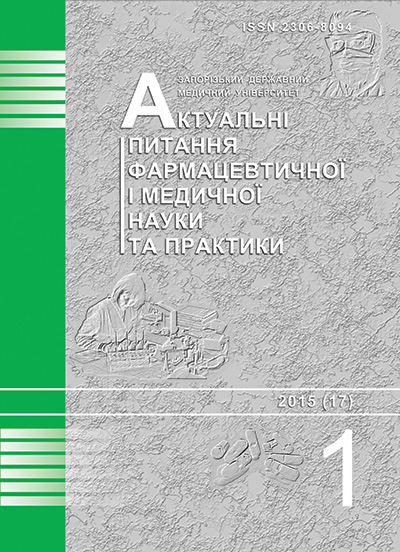Evaluation of relationship between endothelial function and vascular-platelet hemostasis in patients with a good compensation of type 2 diabetes mellitus and hypertension
DOI:
https://doi.org/10.14739/2409-2932.2015.1.41652Keywords:
Diabetes Mellitus Type 2, Hypertension, Endothelium, HemostasisAbstract
The aim of research.
The aim of this study is to determine the relationships between endothelial dysfunction, the degree of renal function damage, lipidemic profile and morphological changes of vascular-platelet hemostasis in patients with good compensation of type 2 diabetes mellitus and arterial hypertension.
Materials and methods.
In 69 patients with good glycemic compensation using clinical, laboratory, morphological methods and correlational analysis association between endothelial dysfunction, degree of renal function damage, lipidemic profile and morphological changes of vascular-platelet hemostasis have been identified.
Results.
Results of correlation analysis showed the presence of credible negative relation between the content of inactivated platelets and concentrations of endothelin-1 (r=-0.53; p<0.05), von Willebrand factor (r=-0.68; p<0.05) and thrombomodulin (r=-0.55; p<0.05). The largest number and strength of correlations between morphological indicators of intravascular platelet activation and studied clinical and laboratory parameters were observed with admiration to the activated and aggregated forms of cells. In particular, elevated levels of activated platelets in patients of this contingent had reliable high degree of direct correlation with the content of glycated hemoglobin (r=+0.79), systolic blood pressure (r=+0.63), the concentration of endothelial dysfunction markers, including the level of albuminuria (r=+0.73), as well as with the values of total cholesterol (r=+0.64) and low density lipoprotein cholesterol (r=+0.79).
Content of aggregated platelets statistically significantly positively correlated with the level of glycated hemoglobin (r=+0.73), all markers of endothelial dysfunction, urea concentration (r=+0.51) and creatinine (r=+0.58). In contrast, the relative content of degranulated platelet establish a reliable correlation only with the levels of endothelin-1 (r=+0.75) and thrombomodulin (r=+0.62). On the level of endothelin-1 and thrombomodulin concentration positive linear correlation was found, but alpha-granules located in shut inverse correlation not only with endothelin-1 (r=-0.57; p<0.05), as well as with the concentration of glycated hemoglobin (r=-0.76; p<0.05) and with dyslipidemic changes.
Increased platelet aggregation activity in patients with good glycemic compensation, which was manifested in a twofold increase in the content of circulating small units was significantly correlated with the level of glycated hemoglobin (r=+0.66) and the values of systolic blood pressure (r=+0.58), as well as concentrations of markers of endothelial dysfunction and renal function, but did not have any significant relationships with blood lipids in patients of this contingent.
Conclusion.
It has been established that in the good glycemic control morphological criteria of platelet hemostasis damage clearly correlated with markers of endothelial dysfunction, but did not show significant relationships with indicators of renal function and blood lipid profile.
References
Dedov, I. I. & Shestakova, M. V. (Eds.) (2011). Saharnyj diabet: ostrye i khronicheskie oslozhneniya [Diabetes: acute and chronic complications]. Moscow: Medicinskoe informacionnoe agentstvo [in Russian].
Torimoto, K., Okada, Y., Mori, H. & Tanaka, Y. (2013). Relationship between fluctuations in glucose levels measured by continuous glucose monitoring and vascular endothelial dysfunction in type 2 diabetes mellitus. Cardiovasc Diabetol, 13, 18–24. doi:10.1186/1475-2840-13-99.
Xu, J. & Zou, M. N. (2009). Molecular insights and therapeutic targets for diabetic endothelial dysfunction. Circulation, 13, 1266–1286. doi: 10.1161/CIRCULATIONAHA.108.835223.
Demirtunc, R., Duman, D. & Basar, M. (2009). The relationship between glycemic control and platelet activity in type 2 diabetes mellitus. J Diabetes Complications, 23(2), 89–94. doi: 10.1016/j.jdiacomp.2008.01.006.
Lusher, T. F. & Barton, M. (1997). Biology of the endothelium. Clin Cardiol, 10(11), 3–10.
Ametov, A. S. (2012). Sakharnyj diabet 2 tipa. Problemy i resheniya [Type 2 diabetes mellitus. Problems and Solutions]. Moscow : GE`OTAR-Media. [in Russian].
Mathewkutty, S. & McGuire, D. K. (2009). Platelet perturbations in diabetes: implications for cardiovascular disease risk and treatment. Expert Rev Cardiovasc Ther, 7(5), 541–549. doi: 10.1586/erc.09.30.
Martin-Gallan, P., Carrascosa, A., Gussinye, M. & Dominguez, C. (2003). Biomarkers of diabetes-associated oxidative stress and antioxidant status in young diabetic patients with or without subclinical complications. Free Rad Biol Med, 34(12), 1563–1574. doi: 10.1016/S0891-5849(03)00185-0.
Heude, B. (2003). Cognitive decline and fatty acid composition of erythrocyte membranes. Amer J Clin Nutrition, 77(4), 803–808.
Vitkovsky, Yu. A., Kuznick, В. I., Solpov, A. N. (2006). Patogeneticheskoe znachenie limfocitarno-trombocitarnoj adgezii [Pathogenetic significance of lymphocyte-platelet adherence]. Medicinskaya immunologiya, 8(5–6), 745–753. [in Russian].
Alekseev, V. V. & Karpishchenko, A. I. (2012) Medicinskie laboratornye tekhnologii. Rukovodstvo po klinicheskoj laboratornoj diagnostike [Medical laboratory technology. Manual of Clinical Laboratory Diagnostics]. (Vols. 1–2). Moscow: GE`OTAR-Media. [in Russian].
Sawatzke, C. L. & Solomons, C. C. (1980). Fixation and embedding of small volumes of platelets for transmission electron microscopy. J Clin Pathol, 33(6), 600–602. doi:10.1136/jcp.33.6.600.
Mironov, A. A., Komissarchik, Yu. Ya. & Mironov, V. A. (1994) Metody e`lektronnoj mikroskopii v biologii i medicine [Electron microscopy methods in biology and medicine : Methodological Guide]. Saint Petersburg: Nauka. [in Russian].
Medvedev, I. N., Savchenko, A. P., Zavalishina, S. Yu., Krasnova, E. G., Kumova, T. A., Gamolina, O. V., et al. (2009). Metodicheskie podkhody k issledovaniyu reologicheskikh svojstv krovi pri razlichnykh sostoyaniyakh [Methodology of blood rheology assessment in various clinical situations]. Rossijskij kardiologicheskij zhurnal, 5, 42–45. [in Russian].
Lakin, G. F. (1990). Biometriya [Biometrics]. Moscow: Vysshaya shkola. [in Russian].
Downloads
How to Cite
Issue
Section
License
Authors who publish with this journal agree to the following terms:
Authors retain copyright and grant the journal right of first publication with the work simultaneously licensed under a Creative Commons Attribution License that allows others to share the work with an acknowledgement of the work's authorship and initial publication in this journal. 
Authors are able to enter into separate, additional contractual arrangements for the non-exclusive distribution of the journal's published version of the work (e.g., post it to an institutional repository or publish it in a book), with an acknowledgement of its initial publication in this journal.
Authors are permitted and encouraged to post their work online (e.g., in institutional repositories or on their website) prior to and during the submission process, as it can lead to productive exchanges, as well as earlier and greater citation of published work (See The Effect of Open Access)

